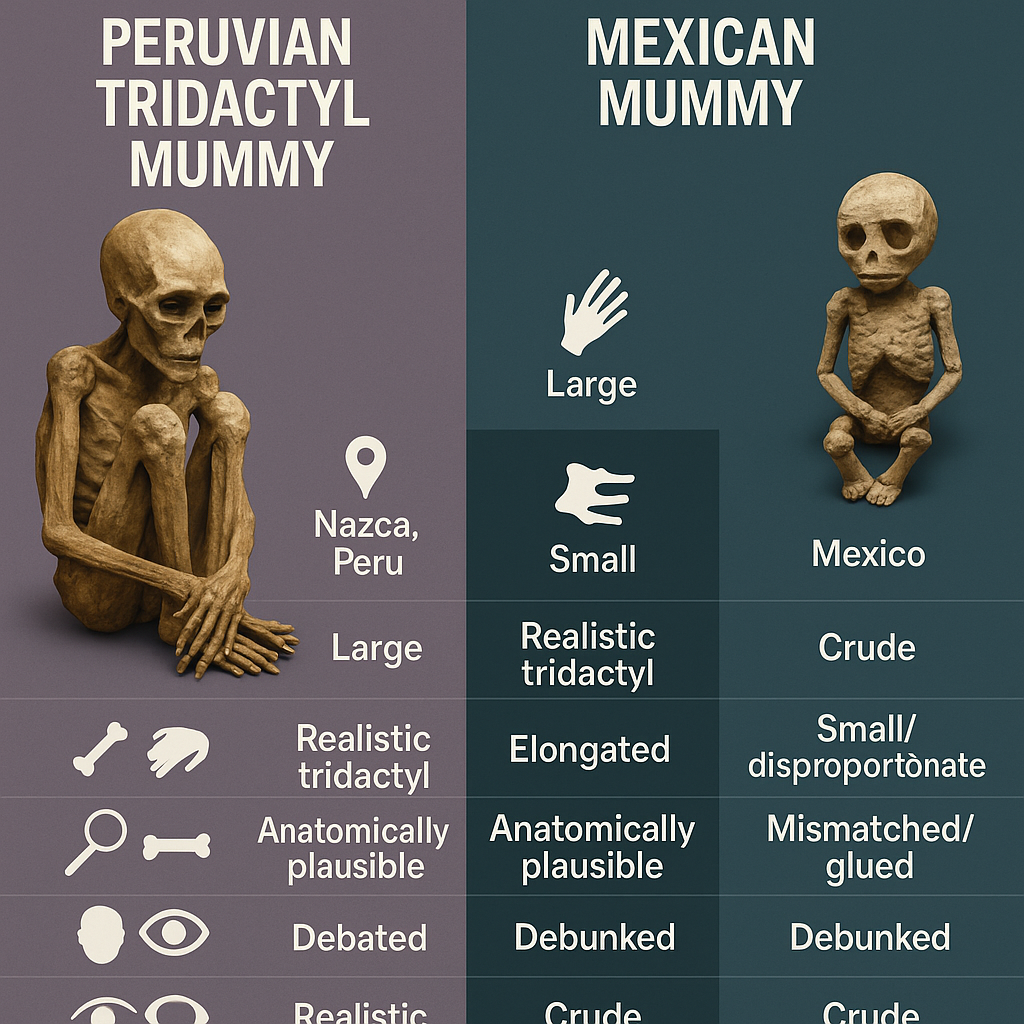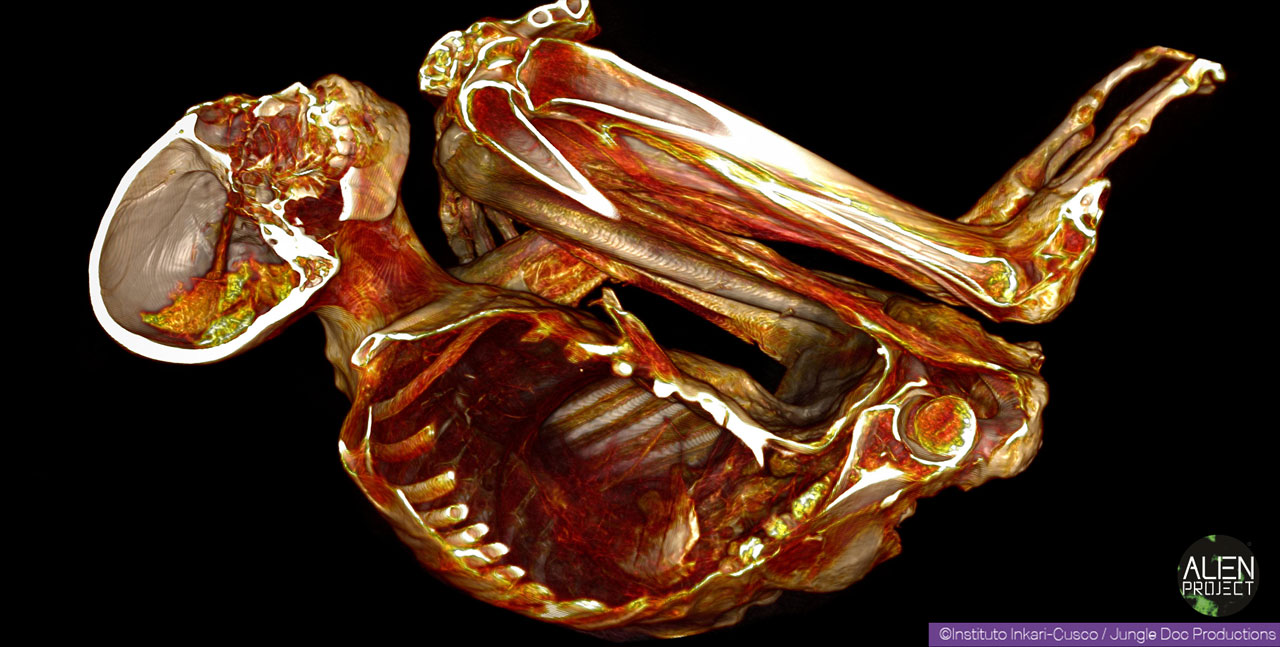The small mummies that were first displayed in Mexico were so obviously fake in my opinion. That was it for me, I no longer cared to investigate such an obvious fake. Then gradually a content creator that I respect, Pavel from Psicoactivo brought the subject back up and backed up these “other” mummies found in Peru. So, I decided to double back on the subject. Representative Eric Burlison was also taking a trip to investigate the subject and what I found shocked me. If this was a hoax, it was the best hoax ever. The skeletons and biology were nothing like those little glued together mummies. These were obviously real, and yes they were true tridactyl mummies. Yes, you read this correctly. Three fingers, three toes, but what does this mean?
Here’s a detailed description and analysis:
Description of the Image
- The image appears to be a high-resolution scan (possibly a CT scan or 3D rendering) of a mummified figure.
- The figure is in a fetal or curled position, with the head tilted back and the arms and legs drawn up.
- The most striking features are:
- Elongated Skull: The cranium is large and extended, with a pronounced dome and a relatively small facial area.
- Tridactyl Limbs: Both the hands and feet show three long, distinct digits (fingers and toes), which is atypical for human anatomy.
- Bone Structure: The bones appear robust and well-articulated, with clear joints and anatomical detail.
- Overall Size: The proportions suggest a larger specimen compared to the much smaller “doll-like” Mexican mummies.
Comparison to Smaller Mexican Mummies
- Size & Proportion: This specimen is much larger and more anatomically detailed than the small, crude Mexican mummies, which are often only a few inches tall and lack realistic bone structure.
- Skeletal Integrity: The bones in this image appear to be naturally connected and articulated, whereas the smaller Mexican mummies have been shown (by forensic analysis) to be assembled from mismatched bones and glued together.
- Head Shape: The elongated skull is a feature sometimes seen in ancient Peruvian cultures (due to cranial deformation practices), but the combination with tridactyl hands and feet is unique and not typical of known human or animal remains.
- Digit Count: The three-fingered and three-toed configuration is not found in any known human or primate species, making this a highly unusual anatomical presentation.
Notes on Authenticity
- While the image is visually compelling and shows a high degree of anatomical detail, it’s important to note that:
- Scientific Consensus: Most mainstream forensic and archaeological experts have concluded that the so-called “tridactyl mummies” are modern fabrications, often assembled from human and animal bones.
- Visual Evidence vs. Analysis: Even highly detailed scans can be made of composite or altered remains. Authenticity requires peer-reviewed, multidisciplinary analysis (DNA, radiocarbon dating, etc.).
Here’s a clear comparison chart highlighting the key differences between the larger Peruvian tridactyl mummies and the smaller Mexican mummies:
Comparison Chart: Peruvian Tridactyl Mummies vs. Mexican Mummies
| Feature | Peruvian Tridactyl Mummies | Mexican Mummies (Small “Alien” Dolls) |
| Origin | Nazca region, Peru | Presented in Mexico, often linked to Peru |
| Size | Larger (often 2–5 feet in length) | Very small (few inches to ~1 foot) |
| Limb Structure | Three long fingers and toes (tridactyl) | Also tridactyl, but less anatomically correct |
| Skull Shape | Elongated, large cranium, sometimes deformed | Small, often disproportionate or crude |
| Bone Articulation | Appears anatomically plausible in scans | Bones often mismatched, glued, or artificial |
| Material | Claimed to be ancient, mummified tissue and bone | Proven to be assembled from human/animal bones |
| Scientific Analysis | Some scans show realistic articulation; debated | Forensic studies confirm modern fabrication |
| DNA/Radiocarbon | Limited, inconclusive, or disputed results | Human/animal DNA, recent manufacture |
| Presentation | Promoted by researchers (e.g., Alien Project) | Presented by Jaime Maussan, others in Congress |
| Expert Consensus | Majority consider them hoaxes, but debate persists | Overwhelming consensus: hoaxes/fabrications |
| Visual Impact | More realistic, detailed, and compelling | Crude, “doll-like,” less convincing |

Conclusion
This image is a powerful example of why the larger Peruvian tridactyl mummies have generated so much debate—they appear far more realistic and complex than the smaller, obviously fake Mexican mummies. However, the scientific community remains skeptical until more transparent, independent studies are published. So, I am still skeptical, but more open to the idea that someday we may just find out that these Peruvian mummies may be revealed to be legit.
Notes:
- The Peruvian mummies are visually more convincing and anatomically complex, but still lack broad scientific validation.
- The Mexican mummies have been thoroughly debunked as modern fabrications using bones and synthetic materials.


Leave a Reply